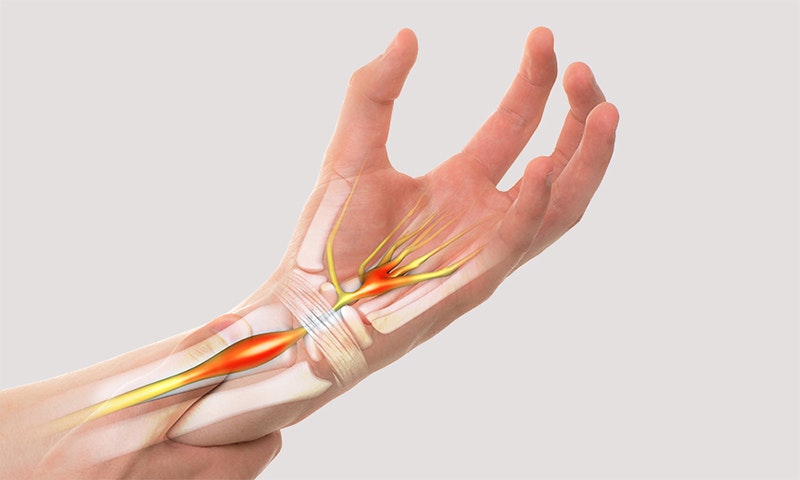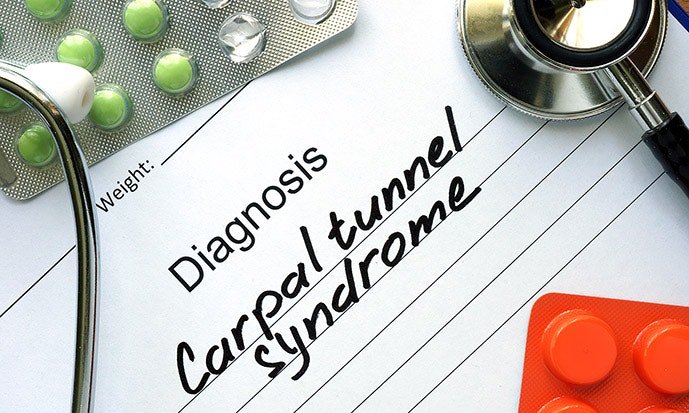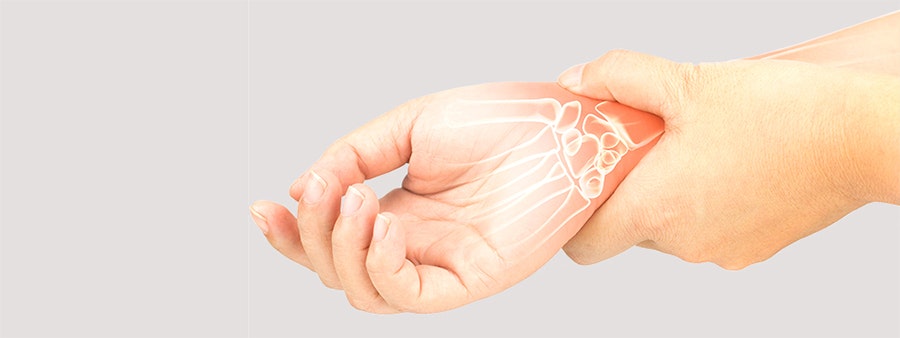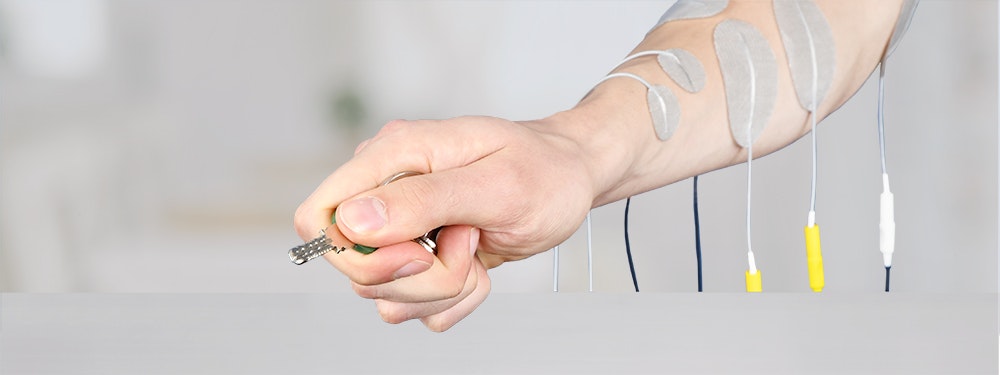Carpal tunnel syndrome
Carpal tunnel syndrome (CTS) is a compression of tendons and nerves within the carpal canal. The damage causes tingling or numbness, as well as pain and muscle loss in prolonged cases.
Learn more about carpal tunnel syndrome in this article: What exactly is carpal tunnel syndrome and what are its symptoms? What causes carpal tunnel syndrome? What are the possible treatments and therapies? And much more …
What is carpal tunnel syndrome?
Carpal tunnel syndrome (ICD-10 code: G56.0) means a compression of anatomical structures in the wrist area. The tendons and nerves running through the carpal tunnel are compressed or clamped.
The carpal tunnel, which is located on the palm side between the carpal bones and the overlying carpal ligament (ligamentum carpi transversum), serves as a passage for tendons (flexor tendons of the fingers) and the median nerve. The median nerve controls
the sensitivity (feeling) of the thumb, index and middle fingers and of the hand. It also controls movement of certain hand and finger muscles.

The median nerve is compressed by the carpal bones and the carpal ligament.
If the middle nerve is compressed in the carpal tunnel, it causes tingling or numbness in the hand or fingers. These symptoms can be initially resolved by shaking the hands. However, in the long run, carpal tunnel syndrome may cause numbness or severe pain that radiates up to the shoulders.
Long-standing compression may also cause muscle atrophy, which cannot be reversed at a late stage. Early treatment is thus essential.
Symptoms of carpal tunnel syndrome
Compression of the median nerve, which underlies carpal tunnel syndrome, initially causes mild sensory disorders in affected persons. Typical symptoms in the early stages of this disease are:
- tingling sensation
- numbness
- repeated ‘falling asleep’ (numbness)
of a single finger or the entire hand.
This condition particularly affects the thumb, index finger, and parts of the ring finger. In most cases, carpal tunnel syndrome affects only one hand, but it can also affect both hands. In addition, the symptoms are initially more pronounced at night when sleeping or early in the morning. The reason for this is that the wrist is often unconsciously bent while sleeping. This prevents proper blood circulation, provokes even more compression of the median nerve, and causes the symptoms described above.
These symptoms usually disappear by shaking or rubbing the hand. Activities such as cycling or using a phone, which are accompanied by strong and repeated shocks or a strong wrist flexion, often cause similar symptoms or increase the effect of the existing symptoms.
If the condition persists for a long time, the initial tingling and mild numbness progress and causepain in the fingers and the hand, which sometimes radiates up the arm. Severe pain is possible, especially when various grasping movements are performed.
If the fingers or the hand are completely numb for a long period of time, activities that require fine motor skills are restricted or no longer possible. Over time, the muscle mass may degrade (muscle atrophy), particularly
at the ball of the thumb (abductor pollicis brevis muscle, opponens pollicis muscle), which is associated with muscle weakness, and may cause a loss of grasping function if medical treatment is not provided.
Progression of carpal tunnel syndrome
Not every case of carpal tunnel syndrome will cause permanent pain or impairment. Symptoms may appear and disappear for years. In many cases, the symptoms disappear on their own after 6 months at the latest, even without treatment. However, the progression of the disease may also be extremely painful, and may worsen over time.
Generally, carpal tunnel syndrome is easy to treat. Serious consequential damage is extremely rare if the condition is treated early.
First aid for carpal tunnel syndrome
First aid for a suspected carpal tunnel syndrome is limited to a few measures.
If you feel tingling or a slight numbness, it can initially be quickly remedied by rubbing or massaging the hand, and by relieving the strain and stabilising the wrists. Activities such as cycling or using a phone should also be discontinued to prevent
shocks and excessive bending of the wrist. This may help loosen the compression and relieve the nerve. It prevents a worsening of the condition.
Diagnosis: carpal tunnel syndrome
In the course of the physician’s diagnosis, a series of medical tests should determine whether there is a carpal tunnel syndrome, or whether it is another condition with similar symptoms.
First of all, the location and type of pain and restrictions are determined by asking the patient the relevant questions.
The following clinical tests can then be used to make more precise assumptions regarding the causes (Assmus & Antoniadis 2014):

- Tinel's sign
In this clinical test, tapping over a superficial nerve indicates whether or not the nerve is damaged. In the case of a suspected carpal tunnel syndrome, the inside of the wrist is tapped. If the affected person feels an uncomfortable, electrifying feeling in the thumb, index finger, or middle finger, the test is positive. This means that the median nerve is damaged due to compression in the carpal tunnel. - Phalen's test
In this clinical test, the patient is asked to hold their wrists in complete flexion for a maximum of 2 minutes. If the test is positive, the patient feels tingling or mild numbness in their thumb, index finger, or middle finger. - Bottle test
The patient is requested to grasp a cylindrical object (for example, a bottle). If the test is positive, the patient cannot close all their fingers around the bottle due to the weakened thumb or finger muscles.
Electrophysiological examinations such as electromyography (EMG) or electroneurography (ENG) can also be used to test the nerve conduction velocity, where necessary.
Imaging tests are also used to make a reliable diagnosis. An X-ray can be used if it is suspected that the issue is caused by the bones. If it seems that damaged tissue may be causing the symptoms, magnetic resonance imaging (MRI) or ultrasound is usually performed.
Women suffer from carpal tunnel syndrome three to four times more often than men. The average age is between 50 and 70 (German societies for hand surgery, neurosurgery, neurology, and orthopaedics (2012).
Differential diagnosis
A differential diagnosis is made in order to differentiate the disease from other similar diseases. Carpal tunnel syndrome may cause symptoms similar to those caused by damage to the cervical spine and polyneuropathy. These possible diseases must thus
be ruled out.
Causes of carpal tunnel syndrome

Carpal tunnel syndrome causes a narrowing of the carpal canal, which in turn causes the structures inside the canal to swell and press on the median nerve. This may result in damage to the muscles and the nerve, and may sometimes cause severe pain.
Carpal tunnel syndrome mostly occurs without apparent causes (idiopathic). In the remaining cases, the main cause is a person's genetic predisposition. A fundamentally narrow anatomical structure in the hand, for example, a specific arrangement of the carpal bones, favours the development of carpal tunnel syndrome.
In rare cases, tumours or injuries (especially fractures) in the wrist may cause nerve compression. Tendonitis may also cause carpal tunnel syndrome due to the associated swelling.
Carpal tunnel syndrome is rarely acute. It usually has a gradual onset. A sudden compression due to fractures, dislocations, or bleeding in the wrist may immediately cause the symptoms of carpal tunnel syndrome.
Risk factors
The genetic predisposition of a person poses a significant risk of developing carpal tunnel syndrome, for example, due to a narrow anatomical arrangement of the carpal bones. Other diseases may also contribute to the development of carpal tunnel syndrome.
This may occur due to inflammation and swelling in the joint in the case of:
- joint wear (arthrosis)
- rheumatic diseases
- metabolic diseases (gout, myxoedema)
Due to increased fluid retention in the case of:
- diabetes
- obesity
- pregnancy
- thyroid dysfunction
Regular dialysis therapy (haemodialysis) may also be a risk factor. It requires permanent access to the blood vessels (shunt). The result is a thickening of the vessels in the shunt arm. The resulting constriction in the forearm may favour the development of carpal tunnel symptoms.
While there is no established link between everyday activities, such as the use of computers, typing, or sport, and the carpal tunnel syndrome, the risk increases for people who are exposed to high wrist load at work, for example, in assembly work. The
workload also causes above-average muscle growth in the wrist area, increasing the risk of a nerve bottleneck. In such cases, care should be taken to take sufficient breaks to prevent a deterioration of the condition.
Treatment of carpal tunnel syndrome
In most cases, carpal tunnel syndrome responds well to conservative treatment. In this case, the physician will first prescribe a splint that needs to be worn only at night or, in the case of advanced deterioration and long-term complaints, also during the day. The splint stabilises the wrist and prevents it from bending, especially at night.
In very mild cases, taping may also be a good alternative. The advantage of taping is that it doesn't limit the wrist in everyday life as much as is the case when wearing a splint. Taping is mostly offered during physiotherapy or occupational therapy.
In principle, overload should be avoided. Daily movements such as cycling, phoning, or rotating movements in the wrist, for example, when turning a screw, should be reduced to a minimum.
Another form of conservative treatment is pharmacological treatment. Pain, inflammation, and swelling can be treated after consulting a physician. Usually, cortisone is given either as a tablet or as an injection. Anti-inflammatory drugs and/or diuretics (to remove water from the body) may also be prescribed. However, this is not a permanent solution and should only be used temporarily.
If the methods described above do not improve the condition, surgery may be performed. The carpal ligament (ligamentum carpi transversum) is cut in an open or endoscopic intervention, which relieves the pressure on the median nerve.
If risk factors and causes are known, the focus is of course on treating them. For example, patients who are suspected of having carpal tunnel syndrome due to obesity are prescribed a diet. Any fractures are treated first, etc.
Rehabilitation of carpal tunnel syndrome

Physiotherapy, occupational therapy, and electrotherapy can be used for the rehabilitation of patients with carpal tunnel syndrome.
Physiotherapy & occupational therapy
Rehabilitation of the hand should begin as soon as possible after the surgery or as soon as the symptoms start affecting everyday life. This can be done in the course of occupational therapy or physiotherapy.
Depending on the load-bearing capacity of the hand and wrist, a series of movement exercises are carried out to prevent muscle loss and to restore full mobility as quickly as possible.
Massages and connective tissue techniques in the area of the hand and the arm may also be used to reduce hand tension due to pain-induced lack of movement or a pathological load distribution, or to make scars more flexible after surgeries. There are often additional muscle constrictions in the course of the nerve, for example, due to spondylolysis in the cervical spine or tension in the pectoral muscle. Treating them also improves the symptoms.
Nerve mobilisation is another method of pain relief during rehabilitation. Here, certain movement exercises are carried out in the area of the shoulder and torso, which improve nerve mobility.
Electrotherapy
Electrotherapy is a good add-on treatment in this regard. Electrotherapy is an efficient and modern rehabilitation option. It can be used as an add-on therapy to strengthen and maintain the muscles, and also for the treatment of pain. Various programmes are used to accelerate the rehabilitation.
Pain can also be effectively treated using TENS programmes or medium-frequency currents.
In the case of denervation, the nerve is squeezed so much that it cannot temporarily conduct impulses or tense the muscle. Both partially denervated and completely denervated muscles can be rebuilt using electrical stimulation. Even the cross-section
and structure of heavily atrophied muscles can be improved by a consistent home-based therapy using special programmes (low frequency, long pulse duration) (Kern et al. 2017).

Functional electrical stimulation (FES) for muscle strengthening and restoring functions in patients with carpal tunnel syndrome.
Initial human studies even demonstrate that electrical stimulation at certain frequencies can promote nerve healing (reinnervation) after surgery (Gordon et al. 2010; Wong et al. 2015). Further research is being carried out to determine the precise parameters.
Electrotherapy can also reliably restore the fine motor skills affected by carpal tunnel syndrome. The EMG-triggered multi-channel electrical stimulation (EMG MES) offers the possibility of training various grasping functions, and of restoring them if necessary.
If you are interested in continuing education on functional electrical stimulation and wish for a STIWELL® training directly at your institute or online, please contact us
Find out how functional electrical stimulation with the STIWELL® can be used to treat carpal tunnel syndrome.
Assmus, H. & Antoniadis, G. (2014). Nervenkompressionssyndrome. (3. Aufl.). Berlin, Heidelberg: Springer Verlag.
Deutsche Gesellschaften für Handchirurgie, Neurochirurgie, Neurologie und Orthopädie (2012). S3-Leitlinie: Karpaltunnelsyndrom. Online: https://www.awmf.org/uploads/tx_szleitlinien/005-003k_S3_Karpaltunnelsyndrom_2012-06-abgelaufen.pdf. (Zugriff am 1.8.2018).
Gordon, T., Amirjani, N., Edwards, D. C., & Chan, K. M. (2010). Brief post-surgical electrical stimulation accelerates axon regeneration and muscle reinnervation without affecting the functional measures in carpal tunnel syndrome patients. Experimental neurology, 223(1), 192-202.
Kern, H., Hofer, C., Loefler, S., Zampieri, S., Gargiulo, P., Baba, A., ... & Carraro, U. (2017). Atrophy, ultra-structural disorders, severe atrophy and degeneration of denervated human muscle in SCI and Aging. Implications for their recovery by Functional Electrical Stimulation, updated 2017. Neurological research, 39(7), 660-666.
Wong, J. N., Olson, J. L., Morhart, M. J., & Chan, K. M. (2015). Electrical stimulation enhances sensory recovery: a randomized controlled trial. Annals of neurology, 77(6), 996-1006.

